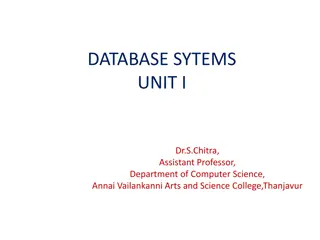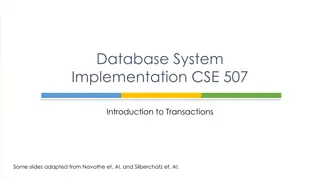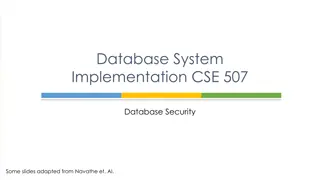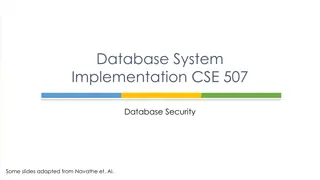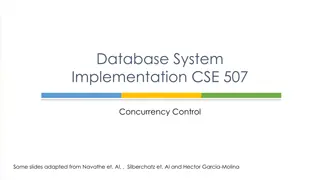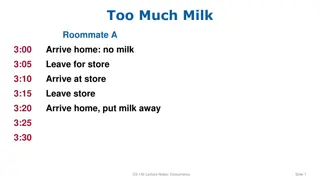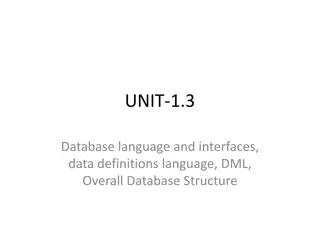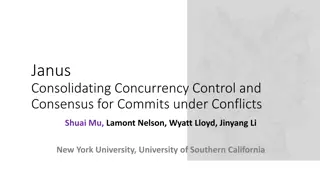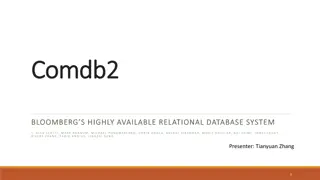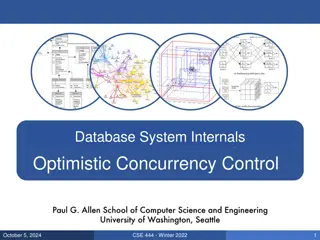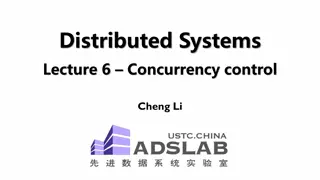Understanding Database Transactions and Concurrency Control
This content delves into the world of database transactions, exploring concepts such as ACID properties, locking schedulers, anomalies in scheduling, and implementing transaction control mechanisms like Two Phase Locking. It covers the importance of maintaining atomicity, consistency, isolation, and durability in transactions, as well as the role of locking mechanisms in ensuring conflict-serializability. The discussion also touches on different concurrency control approaches used by various database vendors.
Download Presentation

Please find below an Image/Link to download the presentation.
The content on the website is provided AS IS for your information and personal use only. It may not be sold, licensed, or shared on other websites without obtaining consent from the author. Download presentation by click this link. If you encounter any issues during the download, it is possible that the publisher has removed the file from their server.
E N D
Presentation Transcript
CSE 344 MARCH 25TH ISOLATION
ADMINISTRIVIA HW8 Due Friday, June 1 OQ7 Due Wednesday, May 30 Course Evaluations Out tomorrow
TRANSACTIONS We use database transactions everyday Bank $$$ transfers Online shopping Signing up for classes For this class, a transaction is a series of DB queries Read / Write / Update / Delete / Insert Unit of work issued by a user that is independent from others
KNOW YOUR TRANSACTIONS: ACID Atomic State shows either all the effects of txn, or none of them Consistent Txn moves from a DBMS state where integrity holds, to another where integrity holds remember integrity constraints? Isolated Effect of txns is the same as txns running one after another (i.e., looks like batch mode) Durable Once a txn has committed, its effects remain in the database
IMPLEMENTING A SCHEDULER Major differences between database vendors Locking Scheduler Aka pessimistic concurrency control SQLite, SQL Server, DB2 Multiversion Concurrency Control (MVCC) Aka optimistic concurrency control Postgres, Oracle: Snapshot Isolation (SI) We discuss only locking schedulers in this class
LOCKING SCHEDULER Simple idea: Each element has a unique lock Each transaction must first acquire the lock before reading/writing that element If the lock is taken by another transaction, then wait The transaction must release the lock(s) By using locks scheduler ensures conflict-serializability
SCHEDULE ANOMALIES What could go wrong if we didn t have concurrency control: Dirty reads (including inconsistent reads) Unrepeatable reads Lost updates Many other things can go wrong too
MORE NOTATIONS Li(A) = transaction Ti acquires lock for element A Ui(A) = transaction Ti releases lock for element A
TWO PHASE LOCKING (2PL) The 2PL rule: In every transaction, all lock requests must precede all unlock requests
EXAMPLE: 2PL TRANSACTIONS T1 L1(A); L1(B); READ(A) A := A+100 WRITE(A); U1(A) T2 L2(A); READ(A) A := A*2 WRITE(A); L2(B); BLOCKED READ(B) B := B+100 WRITE(B); U1(B); GRANTED; READ(B) B := B*2 WRITE(B); U2(A); U2(B); Now it is conflict-serializable
TWO PHASE LOCKING (2PL) Theorem: 2PL ensures conflict serializability Proof. Suppose not: then there exists a cycle in the precedence graph. Then there is the following temporal cycle in the schedule: U1(A) L2(A) L2(A) U2(B) U2(B) L3(B) L3(B) U3(C) U3(C) L1(C) L1(C) U1(A) C T1 T3 B A T2 Cycle in time: Contradiction 11
A NEW PROBLEM: NON-RECOVERABLE SCHEDULE T1 L1(A); L1(B); READ(A) A :=A+100 WRITE(A); U1(A) T2 L2(A); READ(A) A := A*2 WRITE(A); L2(B); BLOCKED Dirty reads of A, B lead to incorrect writes. READ(B) B :=B+100 WRITE(B); U1(B); GRANTED; READ(B) B := B*2 WRITE(B); U2(A); U2(B); Commit Elements A, B written by T1 are restored to their original value. Rollback Can no longer undo!
STRICT 2PL The Strict 2PL rule: All locks are held until commit/abort: All unlocks are done together with commit/abort. With strict 2PL, we will get schedules that are both conflict-serializable and recoverable
STRICT 2PL T1 L1(A); READ(A) A :=A+100 WRITE(A); T2 L2(A); BLOCKED L1(B); READ(B) B :=B+100 WRITE(B); Rollback & U1(A);U1(B); GRANTED; READ(A) A := A*2 WRITE(A); L2(B); READ(B) B := B*2 WRITE(B); Commit & U2(A); U2(B);
STRICT 2PL Lock-based systems always use strict 2PL Easy to implement: Before a transaction reads or writes an element A, insert an L(A) When the transaction commits/aborts, then release all locks Ensures both conflict serializability and recoverability
ANOTHER PROBLEM: DEADLOCKS T1: R(A), W(B) T2: R(B), W(A) T1 holds the lock on A, waits for B T2 holds the lock on B, waits for A This is a deadlock!
ANOTHER PROBLEM: DEADLOCKS To detect a deadlocks, search for a cycle in the waits-for graph: T1 waits for a lock held by T2; T2 waits for a lock held by T3; . . . Tn waits for a lock held by T1 Relatively expensive: check periodically, if deadlock is found, then abort one TXN; re-check for deadlock more often (why?)
LOCK MODES S = shared lock (for READ) X = exclusive lock (for WRITE) Lock compatibility matrix: None S X None S X
LOCK MODES S = shared lock (for READ) X = exclusive lock (for WRITE) Lock compatibility matrix: None S X None S X
LOCK GRANULARITY Fine granularity locking (e.g., tuples) High concurrency High overhead in managing locks E.g., SQL Server Coarse grain locking (e.g., tables, entire database) Many false conflicts Less overhead in managing locks E.g., SQL Lite Solution: lock escalation changes granularity as needed
LOCK PERFORMANCE Throughput (TPS) To avoid, use admission control thrashing Why ? TPS = # Active Transactions Transactions per second
PHANTOM PROBLEM So far we have assumed the database to be a static collection of elements (=tuples) If tuples are inserted/deleted then the phantom problem appears
Suppose there are two blue products, A1, A2: PHANTOM PROBLEM T1 SELECT * FROM Product WHERE color= blue T2 INSERT INTO Product(name, color) VALUES ( A3 , blue ) SELECT * FROM Product WHERE color= blue Is this schedule serializable ?
Suppose there are two blue products, A1, A2: PHANTOM PROBLEM T1 SELECT * FROM Product WHERE color= blue T2 INSERT INTO Product(name, color) VALUES ( A3 , blue ) SELECT * FROM Product WHERE color= blue R1(A1);R1(A2);W2(A3);R1(A1);R1(A2);R1(A3)
Suppose there are two blue products, A1, A2: PHANTOM PROBLEM T1 SELECT * FROM Product WHERE color= blue T2 INSERT INTO Product(name, color) VALUES ( A3 , blue ) SELECT * FROM Product WHERE color= blue R1(A1);R1(A2);W2(A3);R1(A1);R1(A2);R1(A3) W2(A3);R1(A1);R1(A2);R1(A1);R1(A2);R1(A3)
PHANTOM PROBLEM A phantom is a tuple that is invisible during part of a transaction execution but not invisible during the entire execution In our example: T1: reads list of products T2: inserts a new product T1: re-reads: a new product appears !
DEALING WITH PHANTOMS Lock the entire table Lock the index entry for blue If index is available Or use predicate locks A lock on an arbitrary predicate Dealing with phantoms is expensive !
SUMMARY OF SERIALIZABILITY Serializable schedule = equivalent to a serial schedule (strict) 2PL guarantees conflict serializability What is the difference? Static database: Conflict serializability implies serializability Dynamic database: This no longer holds
ISOLATION LEVELS IN SQL 1. Dirty reads SET TRANSACTION ISOLATION LEVEL READ UNCOMMITTED 2. Committed reads SET TRANSACTION ISOLATION LEVEL READ COMMITTED 3. Repeatable reads SET TRANSACTION ISOLATION LEVEL REPEATABLE READ ACID 4. Serializable transactions SET TRANSACTION ISOLATION LEVEL SERIALIZABLE
1. ISOLATION LEVEL: DIRTY READS Long duration WRITE locks Strict 2PL No READ locks Read-only transactions are never delayed Possible problems: dirty and inconsistent reads
2. ISOLATION LEVEL: READ COMMITTED Long duration WRITE locks Strict 2PL Short duration READ locks Only acquire lock while reading (not 2PL) Unrepeatable reads: When reading same element twice, may get two different values
3. ISOLATION LEVEL: REPEATABLE READ Long duration WRITE locks Strict 2PL Long duration READ locks Strict 2PL Why ? This is not serializable yet !!!
4. ISOLATION LEVEL SERIALIZABLE Long duration WRITE locks Strict 2PL Long duration READ locks Strict 2PL Predicate locking To deal with phantoms
BEWARE! In commercial DBMSs: Default level is often NOT serializable Default level differs between DBMSs Some engines support subset of levels! Serializable may not be exactly ACID Locking ensures isolation, not atomicity Also, some DBMSs do NOT use locking and different isolation levels can lead to different problems Bottom line: Read the doc for your DBMS!
CONCLUSION May different elements can be tuned ACID constraints may not always be totally necessary HW8 Simple implementation Prioritizing throughput
NEXT WEEK Wednesday Brief survey of topics in applied usage Not on final exam Friday Exam review June 6th 8:30a




